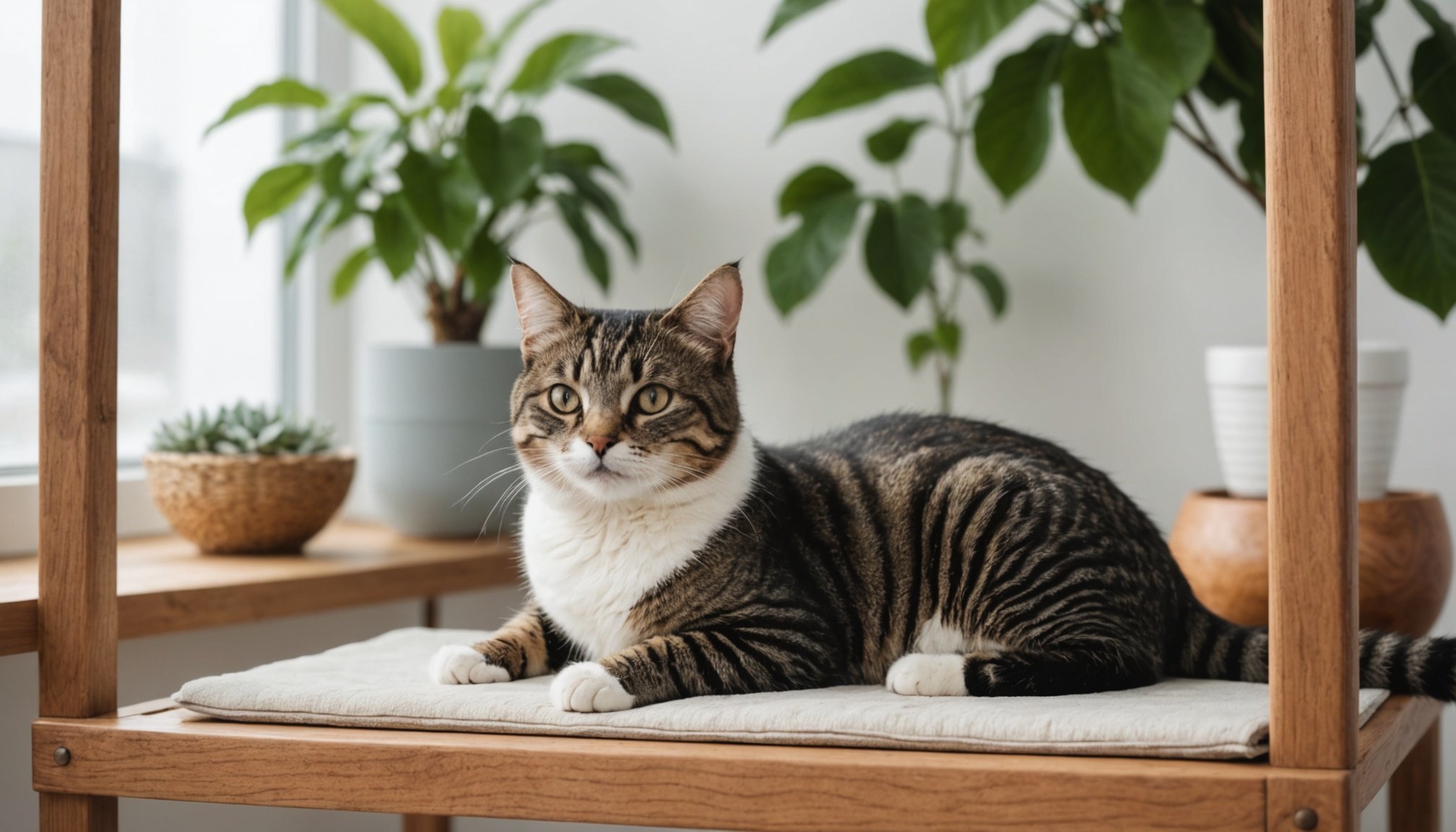Understanding Hyperesthesia in Cats
Hyperesthesia in cats is a condition that causes episodic sensitivity affecting their skin, particularly along the back. This may manifest in twitching, rippling, or an exaggerated response to touch. It often presents as sudden bouts of frantic grooming or chasing the tail. This peripheral sensitivity highlights the importance of understanding these signs early. Consider the impact of current stressors on the environment. These may exacerbate a cat’s discomfort, leading to amplified behavioral reactions. Keeping feline comfort in mind is important not only for diagnosing hyperesthesia but also for managing it effectively.
Cats, much like humans, experience stress from changes or disruptions. Such environmental stressors can include a new pet, loud noises, or even rearranging furniture. These scenarios may unknowingly trigger or worsen the condition. Thus, a stressed cat might react unpredictably or show signs of distress. It is crucial for owners to prioritize their cat’s well-being and mental health to ensure they thrive in their living spaces. Cultivating a safe, predictable atmosphere can be beneficial. As owners gain an understanding of the condition and adjust their approach, they can foster a more comfortable environment that supports their pet’s needs.
Also read : Proven Techniques to Help Your Shy Dachshund Puppy Thrive Socially
Key Environmental Factors for a Calming Space
Creating a calming environment for is essential for their overall well-being. Designing a space that caters to their needs can reduce stress and enhance comfort.
Color Schemes
Choosing soothing colors for walls and furniture can significantly impact a cat’s mood. Soft blues, greens, and pastel shades are known to have calming effects, making them ideal choices. These colors mimic natural landscapes, promoting tranquility and reducing overstimulation. While cats cannot perceive colors exactly as humans do, these muted tones help create a peaceful atmosphere, contributing to their comfort and relaxation.
Have you seen this : Creating a Peaceful Paradise: Essential Tips for a Tranquil Home for Your Rescue Cat
Lighting Considerations
Natural light is important in cat spaces, as it helps regulate their circadian rhythms. Position furniture near windows to provide ample daylight. In the absence of natural light, soft, adjustable lighting fixtures are recommended. Warm-toned LED lights can create a serene environment, minimizing harsh shadows and preventing unnecessary stress. Designing spaces with adjustable lighting allows for control over intensity, catering to a cat’s sensitivity.
Space Design
To ensure feline comfort, consider creating designated safe zones within the home. These areas offer refuge, allowing cats to retreat when they feel overwhelmed. Incorporating vertical space and hiding spots can enrich the environment, promoting exploration and providing security.
Cat-Friendly Furnishings and Layout
Crafting a feline-friendly environment is a nuanced endeavor, focused on cat furniture and their feline architecture. Selecting furniture designed with your cat’s comfort in mind is pivotal. Soft materials, like plush fabrics, offer valuable tactile comfort. This comfort is also found in strategically placed cozy beds and perches, where cats can bask in warmth or observe from above—a natural inclination for them.
Arranging furniture can also play a crucial role in minimizing stress and encouraging exploration. Provide open pathways that allow your cat to navigate with ease, reducing the risk of startled reactions. Incorporating vertical elements, like cat trees or wall-mounted perches, satisfies their innate desire to climb and observe their surroundings from a vantage point.
Relaxation zones are essential. Offering multiple areas where your cat can retreat when seeking solitude or security reflects an understanding of their behavioral needs. A well-thought-out combination of these furniture choices and layout solutions aids in promoting a stress-free environment. With a mind toward both comfort and stimulation, owners can foster an atmosphere where hyperesthetic cats can truly feel at home.
Enrichment Activities for Relaxation
Engaging in cat enrichment can significantly aid in managing stress for hyperesthetic cats. Interactive toys serve as both stimulating and calming tools. They should be chosen carefully to avoid overstimulation. For instance, wand toys or puzzle feeders provide engagement, while still allowing your cat to maintain a sense of control and comfort.
Interactive Toys
Introducing toys like soft balls or feathers can enhance a cat’s environment. These toys cater to their sensory needs without causing anxiety. It’s important to observe your cat’s reaction, adapting the variety of toys according to their unique preferences.
Creating Sensory Experiences
Adding variety through textures and scents can contribute to a calming play experience. Soft, plush fabrics invite tactile exploration, while gentle, cat-safe scents like lavender or chamomile promote relaxation. Additionally, incorporating soothing background sounds or soft music can create a peaceful ambiance.
Engaging in Gentle Play
Playtime should be structured to suit sensitive cats. Gentle interactions, like slow movements or games that encourage stealth, provide needed stimulation without causing stress. Maintaining a balanced routine, ensuring equal parts of play and rest, is key to promoting a relaxed and happy feline environment.
Incorporating Calming Elements
For hyperesthetic cats, integrating calming techniques within their environment can significantly aid in stress reduction. Natural remedies such as specific scents are known to soothe feline nerves. Scents like lavender and chamomile can gently relax your cat, encouraging a more tranquil atmosphere. Pheromone diffusers, which mimic natural feline pheromones, are another effective method to foster a serene setting. They work by reducing anxiety, thus contributing to overall feline comfort.
The ambiance of a cat’s surroundings can also be enhanced through sound. Soft, calming music or nature sounds have been found beneficial in creating a relaxed environment. It’s essential to ensure that any sound introduced is at a low volume and without sudden, harsh elements that might startle sensitive cats.
Incorporating these environmental enrichment tools requires careful observation. Monitor your cat’s responses to different scents and sounds. Adjust accordingly to ensure the most favourable effect on their comfort and anxiety levels. By thoughtfully combining these elements, a more peaceful feline sanctuary can be established, one that accommodates the unique needs of hyperesthetic cats and promotes their mental well-being.
Additional Resources and Research
To further assist in understanding hyperesthesia in cats, cat behavior studies and expert research can provide invaluable insights. These resources delve into the complexities of cat behavior and the effects of various environmental factors on feline comfort. For example, scholarly articles highlight the importance of tailored care strategies that address each cat’s unique needs and sensitivities. One such study discusses how the diversity of environmental stimuli can impact a cat’s mood and physiological state, offering strategies for mitigating negative effects.
Consulting feline care resources helps equip owners with practical solutions for managing hyperesthesia effectively. Experts often recommend establishing a routine that includes consistent monitoring of cats’ reactions to environmental changes. By tapping into expert recommendations and continually adapting your home environment, you can ensure a more comfortable and stress-free life for your cat. Engaging with online forums, veterinary advice columns, and dedicated cat behaviorists can provide additional perspectives and tips as well.
Furthermore, it’s crucial to prioritize ongoing observation and adaptation. Keeping abreast of the latest research developments can help you refine your approach, thereby enhancing your cat’s overall mental health and well-being.






